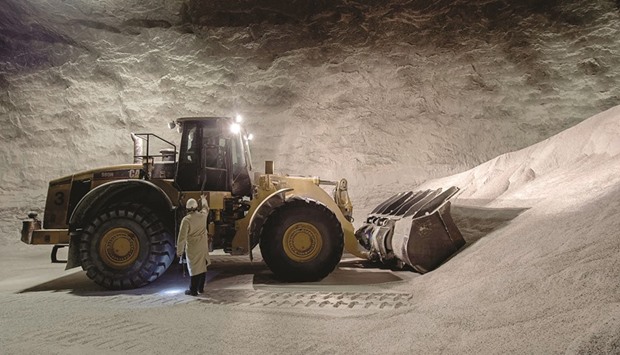Salt mines are supposed to be terrifying underground hells, but down in one of Germany’s main commercial salt deposits, it’s strangely calm.
The off-white salt walls gleam like the snow on a clear winter night. Salt dust glistens in the light and covers everything, including the skin and lips of the miners at work. When the machinery stops, total silence reigns.
The Stetten Salt Mine near Haigerloch in the German state of Baden Wuerttemburg has been in operation for 160 years, extracting salt from under the Swabian Alb mountains.
A vast labyrinth of cool, dry tunnels have been created during this period to extract the vast reserves of salt located 100 to 150 metres below the surface.
The mine’s operating manager Michael Schulz has worked in the mining industry for 35 years — 20 of those at Stettin — and gives a tour of the underground complex he knows like the back of his hand.
“It’s a world of its own down here,” he says. “Everyone has to be able to rely on everyone else.”
The underground tunnel network combines to a length of 200 kilometres and resembles a fish skeleton. It has a broad central road criss-crossed by smaller tunnels to the left and right where the salt is extracted with the help of explosives.
The visiting group has lost total orientation in the tunnel complex by the time Schulz has swerved in and out of tunnels and finally stops his vehicle at the active mine face.
A miner is using a 7-metre-long drill to bore holes in the wall before stuffing them with an explosive charge. Once loosened, the rock salt is hauled away by diggers, then transported on a conveyor belt to a huge silo where it is dropped into one of the approximately 14,000 trucks that come to the mine each year to load up with salt.
Much of the 500,000 tons of salt mined here annually is used to salt German roads during the cold winter months. Salt lowers the freezing temperature of water, making ice and snow on the roads melt so that vehicles will not skid.
Annual output is therefore heavily dependent on climate factors. Not surprisingly, mild temperatures make mine director Frank Joppen slightly nervous.
“We are depending on a good winter,” says Joppen, by which he means daytime sleet or freezing rain and night temperatures dropping to between 2 and 3 degrees below zero Celsius.
“It’s the kind of weather that no one else wants,” he admits.
That sort of weather obliges 350 municipal and local authorities within a 300-kilometre radius of Haigerloch to send out their gritting vehicles, which in turn results in orders for more salt from Joppen’s mine.
The use of salt for gritting has become a controversial issue in Germany due to environmental concerns. Salt in the soil can kill off plant growth.
Modern gritting vehicles now spread salt with less wastage, meaning less is required, but salt sales have remained constant for the Stettin mine because the size of the region’s road network keeps increasing, explains Joppen.
The German Nature and Biodiversity Conservation Union Germany (NABU) argues that salt on roads alters the surrounding soil’s nutrient content. This is most evident when trees wither in spring due to a lack of water, says NABU spokeswoman Anke Beisswaenger.
Whatever legal rules eventuate over salt use, the mine in Haigerloch has sufficient reserves to continue production for another couple of decades.
Even then the mine will not close. Its owner, the Wacker corporation, intends making more profit from the complex by offering the tunnels as an eternal storage site for mineral waste, contaminated earth, ash and chemical residue. —DPA

At work: A wheeled excavator picks up rock salt inside the Stetten Salt Mine in Germany.


